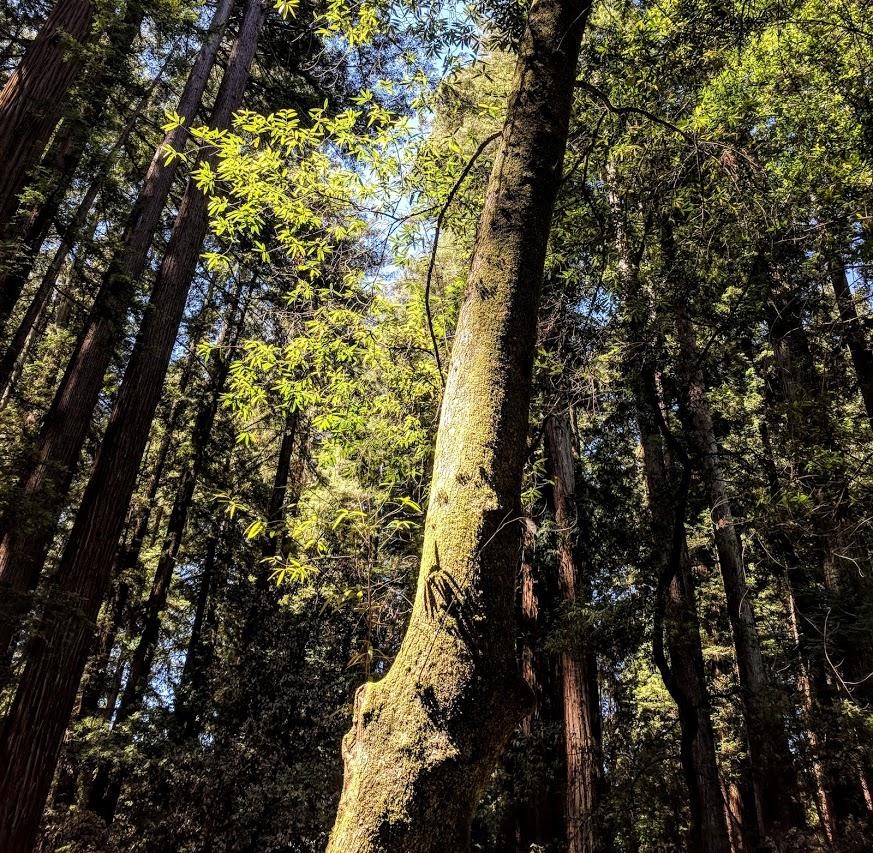- About Us
- Our Work
- Tree Info
- Get Involved
- Blog
- Support Us
By Canopy Team on March 4, 2019

California bay tree growing among redwoods. Photo by Galyna Vakulenko
Tree Spotlight Series: Follow along as we learn about the fascinating trees that live among us. This series is in partnership with Rhee Lab in the Plant Biology Department of the Carnegie Institution for Science.
Other posts in the series: ginkgo biloba, Douglas fir, giant sequoia, Chinese tallow, silver-dollar gum, Monterey pine, green dracaena, coast live oak, cork oak, Japanese maple, silver birch, dawn redwood, Japanese persimmon ‘Hachiya’, and carob.

California bay (Umbellularia californica) is a tall evergreen tree that grows along the Pacific coast of California and Oregon. In California, it is called the California bay, and in Oregon, it is known as the Oregon myrtle. It is a valuable part of the US cultural landscape, for it has been used as a food, spice, medicine, and at one point, as legal tender.
A strong spice, the California bay closely resembles the Mediterranean bay laurel tree (Laurus nobilis), which is where common bay leaves used in cooking come from. In fact, leaves from the California bay can also be used as a spice. However, California bay leaves have a much stronger aroma and even a single leaf can overpower a soup.

The spicy smell of bay leaves is created by a mix of many terpene compounds, but the main compound is eucalyptol (which is also present in all eucalyptus trees).
The California bay is also unique in that its scented leaves contain a high amount of the monoterpene umbellulone. This is used by the plant as an insecticide. Keeping a mature California bay leaf in your pantry or under your mattress can help repel pests.
The tree was important to the California Native Americans as a source of food and medicine. It is a relative of the avocado and produces a similar fatty fruit with a large dense seed. The fruit has a similar, but more floral and bitter taste than avocados. The seed, called the bay nut, can be peeled, roasted, and eaten. It tastes earthy, like dark chocolate.
As a medicine, the leaves of the California bay were used to treat congestion, toothaches, and headaches. This is surprising, since umbellulone is actually known to cause severe headaches. This gave the tree the nickname “headache tree”.

In 1933, during the Great Depression, the only bank in North Bend, Oregon temporarily closed its doors. This caused a problem with money flow in the city, so the government came up with a solution. They cut small discs from the California bay tree and used a newspaper printing press to print values ranging from 25 cents to $10 on them.
These coins were used as a temporary currency, meant to be traded in for money once it was available. However, when the bank reopened, many people were reluctant to trade the wooden coins in. Since these coins remained in circulation, it was decided that myrtlewood money would remain legal tender in North Bend forever. The coins are now a collector’s item, and they are sold for much more than their face value.

Galyna Vakulenko was a 2018 summer intern at the Rhee Lab in the Plant Biology Department of the Carnegie Institution for Science at Stanford University. She is an undergraduate student majoring in plant physiology at Carleton University in Ottawa, Canada.